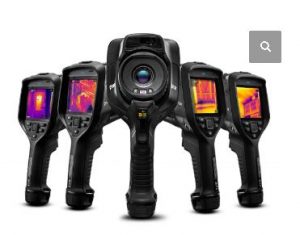
Choosing an infrared camera be a complicated process. You want an equipment that balances high specifications and value for money.
That’s where the Raythink RT630 comes in—a smart, high-performance thermal imager designed to make your work faster, clearer, and more efficient. Below, we’ll explore how Raythink’s latest device stands apart from the rest.
Marcus Yap from NAX Instruments partners with Marcus Huang from IIRT – the Institute of Infrared Thermography to dive into the RT630 and see what makes it stand out.

Marcus from IIRT is amazed at the clarity on the Raythink RT630.
What Makes the Raythink RT630 Stand Out?
🔍 Sharp Thermal Imaging
The Raythink RT630 delivers 640×512 resolution with <35mK thermal sensitivity. That means you’ll catch even the slightest temperature anomalies—essential for uncovering faults before they fail. With Super Resolution mode and a laser rangefinder, your scans are always crisp and targeted.

Comparing screen size of the screen size.
🌡️ Flexible Temperature Range
From HVAC cold spots to industrial heat processes, the Raythink RT630 handles temperatures from -20°C to 650°C, and up to 1500°C with an upgrade. Its smart auto-switching mode helps you stay efficient without needing manual recalibration.
🔧 Interchangeable Lenses
This camera adapts to your inspection needs:
- 25° standard lens for general use
- 7° telephoto for distant targets
- 45° wide-angle for cramped electrical spaces
- Macro lenses for fine details in R&D or electronics

Speedy and snappy performance.
📲 Smart Onboard Features
Powered by Android OS, the Raythink RT630 operates like a modern smartphone—with fast navigation, on-camera report generation, and built-in PDF creation. You can even email results directly from the field.
📷 Rich Visual Output
Its 5″ OLED screen, 13MP visual camera, and 19 color palettes enhance your ability to interpret data on the spot. Real-time measurement tools like spot, line, and area markers support thorough analysis.
Built for Busy Professionals
- Electricians & Maintenance Teams: Quickly detect hot spots or loose connections in switchboards—even in tight or cluttered spaces.
- Building Inspectors: Spot water ingress, thermal leaks, or facade faults—ideal for Singapore’s high-rise challenges.
- Industrial Engineers & R&D: Perform high-heat process monitoring, material testing, or trend analysis with precision.
And with voice notes, time-lapse video, and radiometric video recording, the Raythink RT630 doesn’t just capture data—it helps you tell the full story.

Generate and send reports directly from the thermal camera
Final Thoughts
With its blend of imaging clarity, field-ready design, and smart features, the Raythink RT630 offers real value for serious professionals. Whether you’re troubleshooting heat or chasing cold, it’s a reliable companion for inspections that demand more than just point-and-shoot.
Ready to raise your inspection game? The RT630 may just be the spark you need.
Watch the Full Raythink RT630 Review
See the Raythink RT630 in action with IIRT’s episode of “Thermal Talk” (Coming Soon). To experience the full range of Raythink Infrared Cameras firsthand, book a product demo with Nax Instruments, contact us here.
IIRT x Nax Instruments
At Nax Instruments, we equip trainees from the Institute of Infrared Thermography (IIRT) with the best thermal imagers to ensure hands-on, real-world learning. Our partnership bridges high-performance infrared technology with industry-compliant education—preparing future thermographers with the tools and confidence to meet inspection standards from day one.
Explore our collaboration here: Level-1 Infrared Thermography Certification Course
In recent years, thermal cameras have emerged as indispensable tools across various industries, revolutionizing the way we perceive and interact with our environment. Utilizing advanced infrared technology, these cameras detect and visualize thermal energy emitted by objects, enabling users to identify temperature variations and anomalies that are invisible to the naked eye. From industrial inspections to medical diagnostics and beyond, thermal cameras offer a multitude of applications and benefits that continue to shape diverse fields.
Understanding Thermal Imaging Technology

At the heart of thermal cameras lies thermal imaging technology, which operates on the principle of capturing and translating infrared radiation emitted by objects into visible images. Unlike conventional cameras that rely on visible light, thermal cameras detect heat signatures emitted by objects, converting them into thermal images known as thermograms. Each pixel in a thermogram represents a different temperature value, allowing users to analyze temperature differentials with precision.
Applications Across Industries
Industrial Inspections: Thermal cameras play a crucial role in industrial settings for preventive maintenance, detecting equipment malfunctions, and identifying potential hazards. By pinpointing temperature irregularities in machinery, electrical systems, and infrastructure, thermal imaging helps prevent costly breakdowns and ensures workplace safety.
Building Diagnostics: In the construction and building maintenance sector, thermal cameras are invaluable for detecting energy leaks, moisture intrusion, and structural defects. Building inspectors use thermal imaging to assess insulation efficiency, identify water damage, and prioritize repairs, leading to improved energy efficiency and structural integrity.
Security and Surveillance: Thermal cameras enhance security and surveillance systems by providing clear visibility in low-light conditions and adverse weather. With the ability to detect human and animal heat signatures, thermal imaging enables effective perimeter monitoring, intruder detection, and search and rescue operations.
Medical Diagnosis: In the medical field, thermal cameras facilitate non-invasive diagnostics and patient monitoring. Thermography, a technique based on thermal imaging, enables healthcare professionals to visualize temperature variations associated with inflammation, circulatory disorders, and other medical conditions, aiding in early detection and treatment planning.
Wildlife Conservation: Thermal cameras are instrumental in wildlife research and conservation efforts, enabling biologists to study animal behavior, track migratory patterns, and monitor endangered species. Thermal imaging provides valuable insights into nocturnal animals’ activities and habitats, facilitating conservation initiatives and biodiversity preservation.
Key Benefits of Thermal Cameras

Enhanced Visibility: Thermal cameras offer superior visibility in low-light conditions, fog, smoke, and dust, allowing users to see beyond the limitations of human vision. This enhanced visibility is especially advantageous in hazardous environments and remote locations where conventional cameras may fail.
Early Detection of Anomalies: By detecting temperature differentials and hotspots, thermal cameras enable early detection of potential hazards, equipment failures, and safety risks. This proactive approach to maintenance and inspection helps minimize downtime, reduce repair costs, and prevent accidents.
Non-Invasive Inspection: Unlike invasive testing methods that require physical contact or dismantling of equipment, thermal imaging offers non-destructive inspection capabilities. This non-invasive approach minimizes disruption to operations, reduces downtime, and extends the lifespan of assets.
Cost-Effective Solutions: Incorporating thermal cameras into maintenance programs and diagnostic protocols can lead to significant cost savings over time. By identifying issues before they escalate, organizations can avoid costly repairs, optimize energy efficiency, and maximize operational performance.
Versatility and Adaptability: Thermal cameras are versatile tools that can be deployed across diverse applications and industries, from industrial facilities and commercial buildings to medical clinics and wildlife reserves. Their adaptability to various environments and conditions makes them indispensable assets for professionals in different fields.
Conclusion:
In conclusion, the power of thermal cameras lies in their ability to reveal hidden insights and provide actionable data across a wide range of applications. Whether used for industrial maintenance, building diagnostics, medical imaging, or wildlife conservation, thermal imaging technology continues to push the boundaries of innovation and redefine the way we perceive our surroundings.
With their unmatched visibility, early detection capabilities, and cost-effective solutions, thermal cameras have become indispensable tools for professionals seeking to optimize performance, enhance safety, and unlock new possibilities in their respective industries.



